Abstract
The problem of heat dissipation has become a key to maintain the operation state and extending the service time of electronic components. Developing effective thermal management materials and technologies is of great significance to solve this problem. Previously, passive cooling using phase change materials (PCMs) has been proposed as a thermal management method for electronic devices. In this work, a hybrid thermal management system coupling the heat storage of PCMs and the thermal conduction of high conductivity materials is designed toward thermal management of electronic devices. Specifically, ternary composite gels consisting of eicosane, styrene-ethylene-butylene-styrene (SEBS) and boron nitride (BN) are fabricated by liquid-phase blending and sol–gel transition toward the highly efficient thermal management of electronic devices. The van der Waals force between SEBS and eicosane and the π–π interaction between SEBS and BN enable the excellent form-stability of the ternary composite gels. Taking advantage of the merits of the functional components, the proposed ternary composite gels demonstrate a high thermal energy storage capacity of 157.5 Jg−1 and high thermal conductivity of 1.08 Wm−1 K−1. The ternary composite gels are applied in the thermal management of CPU and chip to reduce their working temperature via the synergistic effect of heat dissipation and heat storage. It is anticipated that the ternary composite gels create a state of the art alternative for the next-generation flexible and multifunctional thermal management devices.
Graphical Abstract









Similar content being viewed by others
References
Kumar R, Geleta R, Pandey A, Sinwar D (2021) Adverse effects of 5th generation mobile technology on flora and fauna: review study. IOP Conf Ser Mater Sci Eng 1099:012031
Kim S, Zhang Y, Yuan C et al (2021) Thermal management of β-Ga2O3 current aperture vertical electron transistors. IEEE Trans Compon Package Manuf Technol 11:1171–1176
Ji C, Wang Y, Ye Z et al (2020) Ice-templated MXene/Ag–epoxy nanocomposites as high-performance thermal management materials. ACS Appl Mater Interfaces 12:24298–24307
Ren Q, Guo P, Zhu J (2020) Thermal management of electronic devices using pin-fin based cascade microencapsulated PCM/expanded graphite composite. Int J Heat Mass Transf 149:119199
Alexander WD (2020) Progress with development of foil and slot thermal transfer technology. Therm Sci Eng Prog 19:100571
Qian X, Zhou J, Chen G (2021) Phonon-engineered extreme thermal conductivity materials. Nat Mater 20:1188–1202
Liu X, Rao Z (2019) Thermal diffusion and phase transition of n-octadecane as thermal energy storage material on nanoscale copper surface: a molecular dynamics study. J Energy Inst 92:161–176
Li T, Lee J-H, Wang R, Kang YT (2013) Enhancement of heat transfer for thermal energy storage application using stearic acid nanocomposite with multi-walled carbon nanotubes. Energy 55:752–761
Yu C, Kim H, Youn JR, Song YS (2021) Enhancement of structural stability of graphene aerogel for thermal energy harvesting. ACS Appl Energy Mater 4:11666–11674
Li T, Lee J-H, Wang R, Kang YT (2014) Heat transfer characteristics of phase change nanocomposite materials for thermal energy storage application. Int J Heat Mass Transf 75:1–11
Hou LG, Wu RZ, Wang XD et al (2017) Microstructure, mechanical properties and thermal conductivity of the short carbon fiber reinforced magnesium matrix composites. J Alloys Compd 695:2820–2826
Wang X, Lu C, Rao W (2021) Liquid metal-based thermal interface materials with a high thermal conductivity for electronic cooling and bioheat-transfer applications. Appl Therm Eng 192:116937
Jia L-C, Jin Y-F, Ren J-W et al (2021) Highly thermally conductive liquid metal-based composites with superior thermostability for thermal management. J Mater Chem C 9:2904–2911
Xu Y, Kraemer D, Song B et al (2019) Nanostructured polymer films with metal-like thermal conductivity. Nat Commun 10:1771
Xiao C, Wu X, Dong X et al (2021) Ultrareliable composite phase change material for battery thermal management derived from a rationally designed phase changeable and hydrophobic polymer skeleton. ACS Appl Energy Mater 4:3832–3841
Zhou Y, Hyuga H, Kusano D et al (2015) Development of high-thermal-conductivity silicon nitride ceramics. J Asian Ceram Soc 3:221–229
Li J, Li F, Zhao X et al (2020) Jelly-inspired construction of the three-dimensional interconnected BN network for lightweight, thermally conductive, and electrically insulating rubber composites. ACS Appl Electron Mater 2:1661–1669
Ouyang Y, Ding F, Bai L et al (2020) Design of network Al2O3 spheres for significantly enhanced thermal conductivity of polymer composites. Compos Part Appl Sci Manuf 128:105673
Nfawa SR, Abu Talib AR, Basri AA, Masuri SU (2021) Novel use of MgO nanoparticle additive for enhancing the thermal conductivity of CuO/water nanofluid. Case Stud Therm Eng 27:101279
Kou Y (2021) An intrinsically flexible phase change film for wearable thermal managements. Energy Storage Mater 221:113145
Li T, Wu M, Wu S et al (2021) Highly conductive phase change composites enabled by vertically-aligned reticulated graphite nanoplatelets for high-temperature solar photo/electro-thermal energy conversion, harvesting and storage. Nano Energy 89:106338
Wu S, Li T, Tong Z et al (2019) High-performance thermally conductive phase change composites by large-size oriented graphite sheets for scalable thermal energy harvesting. Adv Mater 31:1905099
Wu S, Li T, Wu M et al (2020) Highly thermally conductive and flexible phase change composites enabled by polymer/graphite nanoplatelet-based dual networks for efficient thermal management. J Mater Chem A 8:20011–20020
Wu S, Li TX, Yan T et al (2016) High performance form-stable expanded graphite/stearic acid composite phase change material for modular thermal energy storage. Int J Heat Mass Transf 102:733–744
Darvin JR, Hossain MS, Nabil M et al (2019) Concentrated Ag nanoparticles in dodecane as phase change materials for thermal energy storage. ACS Appl Nano Mater 2:6187–6196
Chen J, Huang X, Sun B, Jiang P (2019) Highly thermally conductive yet electrically insulating polymer/boron nitride nanosheets nanocomposite films for improved thermal management capability. ACS Nano 13:337–345
Yao B, Zhu H, Ding Y et al (2022) Thermal management of electronics and thermoelectric power generation from waste heat enabled by flexible Kevlar@SiC thermal conductive materials with liquid-crystalline orientation. Energy Convers Manag 251:114957
Wu Z, Xu C, Ma C et al (2019) Synergistic effect of aligned graphene nanosheets in graphene foam for high-performance thermally conductive composites. Adv Mater 31:1900199
Dinker A, Agarwal M, Agarwal GD (2017) Heat storage materials, geometry and applications: a review. J Energy Inst 90:1–11
Wu MQ, Wu S, Cai YF et al (2021) Form-stable phase change composites: preparation, performance, and applications for thermal energy conversion, storage and management. Energy Storage Mater 42:380–417
Luo Y, Yu W, Qiao J et al (2022) Self-healing inorganic hydrated salt gels for personal thermal management in the static and dynamic modes. Chem Eng J 440:135632
Wu M, Li T, Wang P et al (2022) Dual-encapsulated highly conductive and liquid-free phase change composites enabled by polyurethane/graphite nanoplatelets hybrid networks for efficient energy storage and thermal management. Small 18:2105647
Xu J, Chao J, Li T et al (2020) Near-zero-energy smart battery thermal management enabled by sorption energy harvesting from air. ACS Cent Sci 6:1542–1554
Rao Z, Huo Y, Liu X, Zhang G (2015) Experimental investigation of battery thermal management system for electric vehicle based on paraffin/copper foam. J Energy Inst 88:241–246
Xu Z, Chen Y, Lin P, Zhu X (2022) Leakproof phase-change glass window: characteristics and performance. Build Environ 218:109088
Wu W, Liu J, Liu M et al (2020) An innovative battery thermal management with thermally induced flexible phase change material. Energy Convers Manag 221:113145
Urban MW, Davydovich D, Yang Y et al (2018) Key-and-lock commodity self-healing copolymers. Science 362:220–225
Zeng Y, Dong J, Khodadadi JM (2021) Thermal coupling-decoupling mechanism of heat transfer across van der Waals interfaces in n-eicosane. Int J Heat Mass Transf 164:120603
Duan Z-Q, Zhong M, Shi F-K, Xie X-M (2016) Transparent h- BN/polyacrylamide nanocomposite hydrogels with enhanced mechanical properties. Chin Chem Lett 27:1490–1494
Cui M, Ren S, Qin S et al (2017) Non-covalent functionalized hexagonal boron nitride nanoplatelets to improve corrosion and wear resistance of epoxy coatings. RSC Adv 7:44043–44053
Miao S, Zhang Y, Shan L et al (2021) A robust supramolecular heterosynthon assembled by a hydrogen bond and a chalcogen bond. Crystals 11:1309
Kim JY (2009) Carbon nanotube-reinforced thermotropic liquid crystal polymer nanocomposites. Materials 2:1955–1974
Wie J, Kim J (2021) Thermal properties of surface-modified and cross-linked boron nitride/polyethylene glycol composite as phase change material. Polymers 13:456
Li X, Chen L, Han W et al (2020) Preparation and thermal properties of shape-stabilized paraffin/ NPGDMA / BN composite for phase change energy storage. Chin J Chem 38:1737–1742
Acknowledgements
This work was financially supported by the National Natural Science Foundation of China (No. U20A20299), Guangzhou Science and Technology Planning Project (No. 202103000042), Guangdong Basic and Applied Basic Research Foundation (2019A1515011379), Guangdong Special Support Program (2017TX04N371) and Guangdong Enterprise Sci-tech Commissioner (GDKTP2020013400).
Author information
Authors and Affiliations
Contributions
LZ provided conceptualization, methodology, investigation, data curation and writing—original draft preparation. PL done conceptualization, methodology, supervision, validation and writing—reviewing and editing. JZ and HS did investigation and software. YC was involved in software and validation.
Corresponding authors
Ethics declarations
Conflict of interest
The authors declare that they have no known competing financial interests or personal relationships that could have appeared to influence the work reported in this paper.
Additional information
Handling Editor: David Cann.
Publisher's Note
Springer Nature remains neutral with regard to jurisdictional claims in published maps and institutional affiliations.
Supplementary Information
Below is the link to the electronic supplementary material.
Rights and permissions
Springer Nature or its licensor (e.g. a society or other partner) holds exclusive rights to this article under a publishing agreement with the author(s) or other rightsholder(s); author self-archiving of the accepted manuscript version of this article is solely governed by the terms of such publishing agreement and applicable law.
About this article
Cite this article
Zou, L., Lin, P., Zhang, J. et al. Highly-efficient thermal management of electronic devices enabled by boron nitride-incorporated phase change material gels. J Mater Sci 57, 20268–20284 (2022). https://doi.org/10.1007/s10853-022-07872-8
Received:
Accepted:
Published:
Issue Date:
DOI: https://doi.org/10.1007/s10853-022-07872-8




